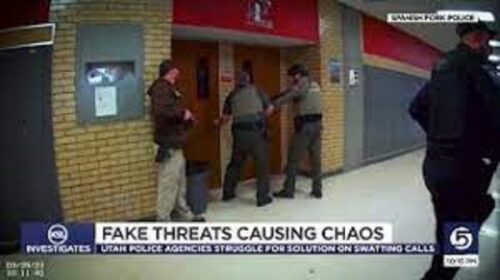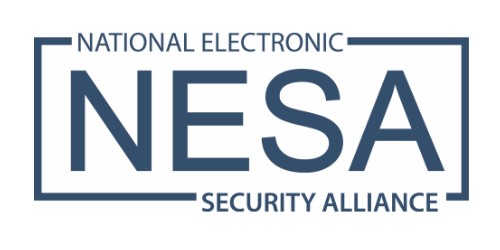
6.30.23 – By Annie Knox and Daniella Rivera, KSL-TV – SALT LAKE CITY
Police storming high school hallways, guns drawn. Students hiding in classrooms. Tearful parents rushing to campus.
This scene played out in communities across Utah on just one day, with reports of an active shooter at a minimum of 13 schools from Logan to St. George.
In reality, there was no gunman at any school. The calls – made on March 29, just two days after a school shooting in Nashville, Tennessee – were a hoax. These kinds of fake reports cause chaos and rattle nerves, law enforcers tell the KSL investigators. But they also pull first responders away from other investigations and calls for help.
While that day was extreme, there have been other examples along the Wasatch Front. Just a week after the chaos in March, another criminal harassment call took officers to the Poplar Grove neighborhood of Salt Lake City. And last month, a false report of a bomb brought police to a Target in Layton.
Hundreds of similar calls have triggered a police response in communities across the country. Many – in Massachusetts, Rhode Island and Pennsylvania and New York, for example – filtered in the same week as the rash of Utah reports.
“Just to find out that’s a hoax? That’s terrible,” Salt Lake City Police Chief Mike Brown said.
He said officers can’t ignore a potential crisis, even if they suspect a report is unfounded.
“We don’t get the luxury to say, ‘Oh, that’s a swatting call,'” Brown said. “We have to respond as if that’s real-time happening.”
We don’t get the luxury to say, ‘Oh, that’s a swatting call.’ We have to respond as if that’s real-time happening.
–Chief Mike Brown, Salt Lake City Police Department
In Salt Lake City, the ruses are pulling police away from other cases at a time when officers are already working mandatory overtime to fill shifts. They also have a big effect on smaller agencies.
Spanish Fork Police Chief Matt Johnson said the city’s police response in March was the largest of any during his 26 years with the department.
“In my opinion, it’s a form of terrorism,” Johnson said. “It’s to get fear and panic out of the students, of the educators, out of the community, and out of law enforcement and first responders as a whole.”
Johnson said he doesn’t know of anyone who couldn’t get help that day because first responders were rushing to Spanish Fork High instead. But he anticipates that could happen in the future.
“It makes me nervous,” Johnson said.
Just how many resources get tied up in these responses? The KSL investigators found most law enforcement agencies don’t specifically track swatting calls. But Johnson combed through reports from March to get us an estimate for just that one day. In Spanish Fork alone, the chief said 75 officers responded.
That includes 18 from his own department, along with others from the Utah County Sheriff’s Office and other agencies, plus another 50 emergency medical technicians and firefighters, and still more city employees. The response and its aftermath tied them up for about three hours. In all, that’s about 400 employee hours spent on a false alarm.
Now consider that multiplied across the state that day for at least 12 other schools.
Then there are the effects that can’t be measured.
“It’s unquantifiable,” said Cheyvoryea Gibson, acting special agent in charge for the FBI in Salt Lake City.
“You not only have the costs associated with mobilizing and deploying special teams, SWAT, bomb techs and things of that nature,” Gibson continued. “But more importantly, you have the emotional toll that it takes on the community, the parents.”
In Spanish Fork, Julyn Shepherd feared the worst when her phone lit up with a message from her daughter, Mandy, saying she was hiding in the bathroom at the high school.
“This is my baby, and you just can’t imagine,” Shepherd said in an interview with KSL that day, fighting tears.
“And then started hearing rumors that it was a hoax,” Shepherd continued. “And then anger kind of hits, because it rocks a whole community.”
The reports that sparked police responses that day in Utah appeared to follow a script, according to state public safety managers. The KSL Investigators obtained the call in Grand County through a public records request.
The voice is faint in the roughly two-minute recording. The words are hard to decipher, but the message is horrifying.
“There’s a shooter inside the high school … he shot five students inside the bathroom,” a voice seems to say. The caller gives an address for Grand County High School, followed by what sounds like panting.
Gibson, with the FBI, declined to talk about the investigation into the calls that day.
But on March 29, the Utah Department of Public Safety told KSL the calls came from the same phone number and the same IP address, from outside the country.
Last month, DPS gave lawmakers an update on the case. Whoever’s behind the reports made them over the internet, a representative from the agency said, using an encrypted connection. And they hacked unsecure routers in the U.S.
In Spanish Fork, students hid in dark closets and classrooms as sheriff’s deputies and officers shouted “Police!” and entered rooms one at a time, asking if there was anyone who wasn’t supposed to be there.
About 40 minutes after officers arrived, the school’s principal announced that everyone was safe, according to body camera video provided by Spanish Fork police. Students were led to a football field to meet parents, and an armored vehicle rolled by school buildings.
Johnson said it was a relief there was no actual shooter, but he’s concerned about potential motivations on the part of whoever made the calls.
“Are they studying our tactics?” Johnson wondered aloud. “Our response times? Are they looking at the security of the school or the lack of security at a school?”
Gibson points out that making a false report to police is a crime, and a conviction carries prison time.
But when it comes to preventing this behavior, there isn’t a clear answer. Even quickly identifying bogus calls as completely false is difficult for police. Gibson said the FBI is working on faster ways to do that, with help from cell phone providers.
“We’re very optimistic that we’re going to get to that point one day in the very near future,” Gibson said. “But again, we’re constantly playing catch up with ever-changing technical landscape.”
Have you experienced something you think just isn’t right? The KSL Investigators want to help. Submit your tip at investigates@ksl.com or 385-707-6153 so we can get working for you.
